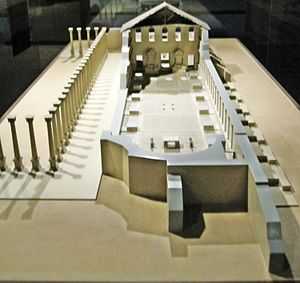Sardis Synagogue
| Sardis Synagogue | |
|---|---|
|
The Gymnasium of Sardis | |
| Basic information | |
| Location | Sardis, Turkey |
| Geographic coordinates | 38°29′18″N 28°02′25″E / 38.48833°N 28.04028°E |
| Affiliation | Judaism |
| Rite | Romaniote |
| Status | Museum |
| Architectural description | |
| Architectural type | Synagogue |
| Completed | Late 3rd century |
Sardis Synagogue is a synagogue located in Manisa Province, Turkey. Sardis was under numerous foreign rulers until its incorporation into the Roman Empire in 133 BCE. The city served then as the administrative center of the Roman province of Lydia. Sardis was reconstructed after the catastrophic earthquake of 17 CE, and it enjoyed a long period of prosperity under the Roman rule.
Sardis is believed to have gained its Jewish community in the 3rd century BCE, as that was when King Antiochus III (223-187 BCE) encouraged Jews from various countries, including Babylonia, to move to Sardis. Josephus Flavius wrote of a decree from Lucius Antonius, a Roman proquestor of 50-49 BCE: "Lucius Antonius...to [the Sardian people], sends greetings. Those Jews, who are fellow citizens of Rome, came to me, and showed that they had an assembly of their own, according to their ancestral laws. [They had this assembly] from the beginning, as also a place of their own, wherein they determined their suits and controversies with one another. Therefore, upon their petition to me, so that these might be lawful for them, I ordered that their privileges be preserved, and they be permitted to do accordingly."1 (Ant., XIV:10, 17). "A place of their own" is generally taken as a reference to the synagogue at Sardis. Josephus Flavius noted that Caius Norbanus Flaccus, a Roman proconsul at the end of the 1st century BCE, upheld the rights of Sardis Jews to practice their religion, including the right to donate to the Temple in Jerusalem. (Ant., XVI:6,6).[1]
Archaeological Expeditions
Since 1958, both Harvard and Cornell Universities have sponsored annual archeological expeditions to Sardis. These excavations unearthed perhaps the most impressive synagogue in the western diaspora yet discovered from antiquity, yielding over eighty Greek and seven Hebrew inscriptions as well as numerous mosaic floors. (For evidence in the east, see Dura Europos in Syria.) The discovery of the Sardis synagogue has reversed previous assumptions about Judaism in the later Roman empire. Along with the discovery of the godfearers/theosebeis inscription from Aphrodisias, it provides indisputable evidence for the continued vitality of Jewish communities in Asia Minor, their integration into general Roman imperial civic life, and their size and importance at a time when many scholars previously assumed that Christianity had eclipsed Judaism.
Manisa (Magnasia), Jewish Community

A Jewish 'romaniote' community existed there from the Byzantine period, praying in the Etz Ha-Hayim Synagogue. After 1492, Jews expelled from Spain settled there, joining a hundred or so romaniote families. These newcomers founded two synagogues: Lorca and Toledo. At the end of the 19th century, Alliance Israelite Universelle inaugurated two schools, one for boys in 1891 and one for girls in 1896. At the beginning of the 20th century, the Jewish community numbered about 2000 souls out of a total population of some 40,000. The Greeks had conquered Manisa in 1919 and when they retreated in 1922, a large conflagration destroyed much of the town including many Jewish institutions. Most of the Jews left their community and emigrated to France, South America, U.S. and Israel. Today, there are no Jews in Manisa. There were three Jewish cemeteries in Manisa.
The most ancient was damaged after the 1878 Turko-Russian war. In 1900 a wall was built around the second cemetery that was until then an open field. The third was acquired in the 1930s. The two ancient cemeteries have since been destroyed. At the time of writing his book, Abraham Galante could still read some of the oldest 16th-century tombstones. The tombstone data of the new cemetery has been collected and computerized by Prof. Minna Rozen (Diaspora Studies Institute of Tel Aviv University) but has not yet been published.[2]
See also
- History of the Jews in Turkey
- Sardis
- Manisa
- List of synagogues in Turkey
- Oldest synagogues in the world
- Priene Synagogue
References and notes
- ↑ "The Ancient Synagogue of Sardis". Retrieved 31 December 2010.
- ↑ "Manisa (Magnasia), Jewish Community". Retrieved 27 April 2008.
External links
- The Archaeological Exploration of Sardis
- Chief Rabbinate of Turkey
- Shalom Newspaper - The main Jewish newspaper in Turkey
Coordinates: 38°29′18″N 28°02′25″E / 38.48833°N 28.04028°E